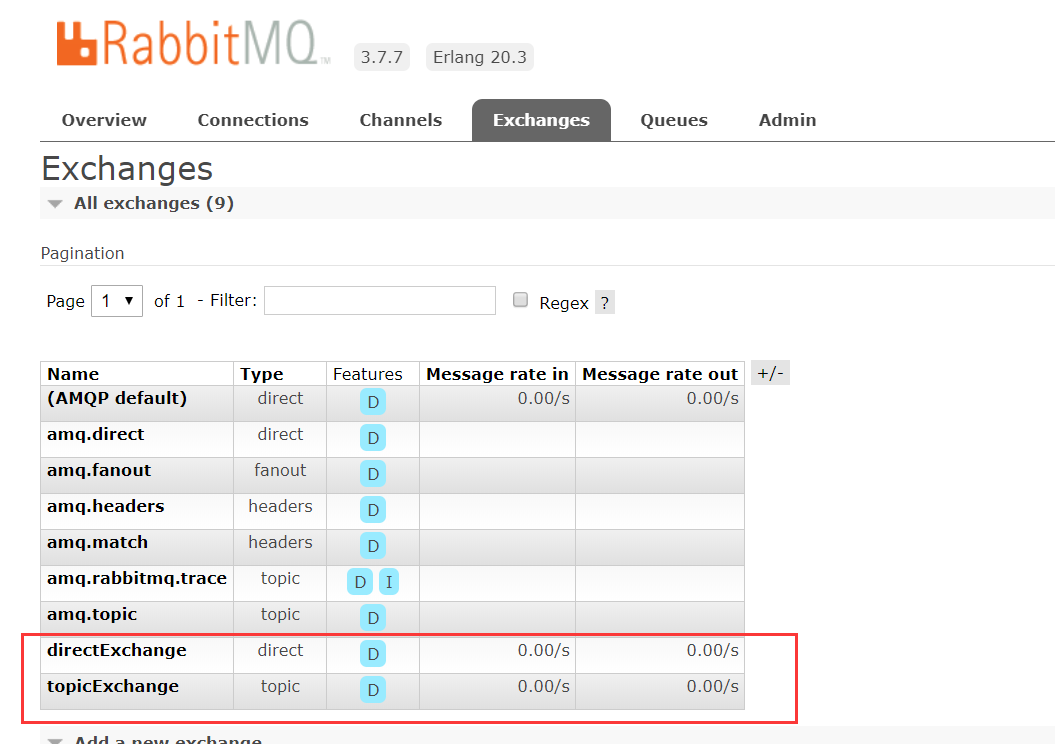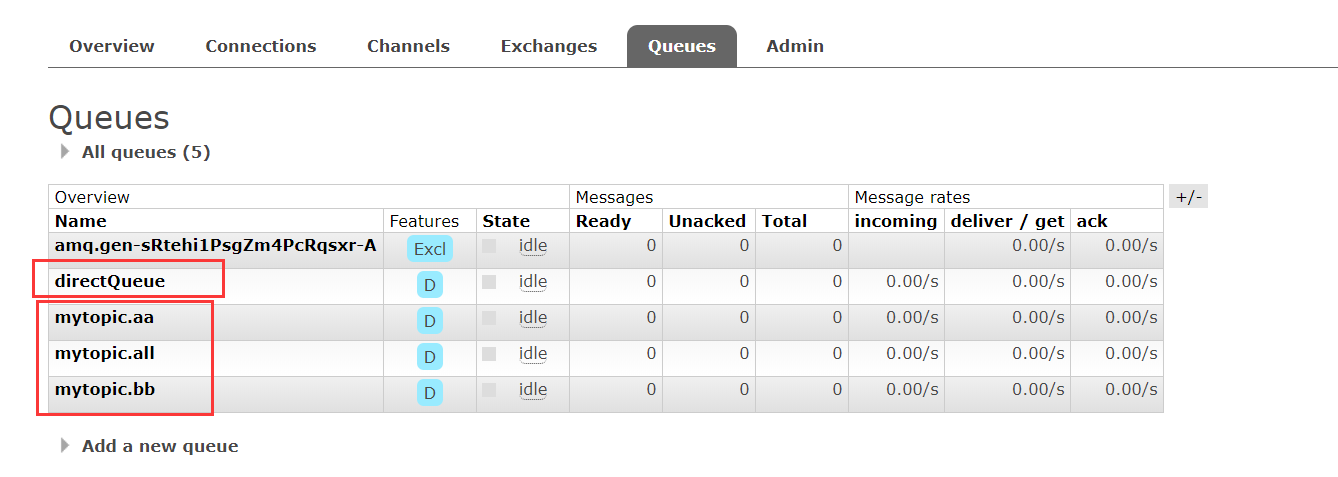springboot中整合rabbitmq(direct队列、topic队列) (原创)
作者: 朝如青丝暮成雪
发布时间:2020-08-08 18:56:02 文章分类:springboot 阅读(853) 评论(0)
发布时间:2020-08-08 18:56:02 文章分类:springboot 阅读(853) 评论(0)
如题: springboot中集成rabbitmq (direct队列、topic队列)
<!--引入mq 依赖-->
<dependency>
<groupId>org.springframework.boot</groupId>
<artifactId>spring-boot-starter-amqp</artifactId>
</dependency>
2、在application.yml中添加mq的相关配置
spring:
rabbitmq:
host: 192.168.11.10
port: 5672
username: rabbitmq
password: rabbitmq123
direct队列,最简单的一种模式(也最常用),一边收一边发,直接通过路由key来接收。
topic队列,使用发布/订阅模式, 一个发布者可以对应多个订阅者。
<!--引入mq 依赖-->
<dependency>
<groupId>org.springframework.boot</groupId>
<artifactId>spring-boot-starter-amqp</artifactId>
</dependency>
2、在application.yml中添加mq的相关配置
spring:
rabbitmq:
host: 192.168.11.10
port: 5672
username: rabbitmq
password: rabbitmq123
virtual-host: /
3、消息队列: direct队列的使用
(1) DirectQueueConfig.java
package com.tingcream.springmq.config;
import lombok.extern.slf4j.Slf4j;
import org.springframework.amqp.core.Binding;
import org.springframework.amqp.core.BindingBuilder;
import org.springframework.amqp.core.DirectExchange;
import org.springframework.amqp.core.Queue;
import org.springframework.context.annotation.Bean;
import org.springframework.context.annotation.Configuration;
/**
* direct队列配置
*/
@Configuration
@Slf4j
public class DirectQueueConfig {
public static final String QUEUE_NAME="directQueue";
public static final String EXCHANGE_NAME="directExchange";
@Bean(name = QUEUE_NAME)
public Queue queue(){
/* (String name, boolean durable(默认true), boolean exclusive(默认false),
boolean autoDelete(默认false),Map<String, Object> arguments(默认null))
*/
return new Queue(QUEUE_NAME);
}
@Bean(name = EXCHANGE_NAME)
public DirectExchange exchange(){
// DirectExchange(name, durable(默认true), autoDelete(默认false),Map<String, Object> arguments(默认null))
return new DirectExchange(EXCHANGE_NAME);
}
@Bean(name = EXCHANGE_NAME+":"+QUEUE_NAME)
public Binding binding(){
Queue queue= queue();
DirectExchange exchange= exchange();
return BindingBuilder.bind(queue).to(exchange).with(queue.getName());
}
}
(2) direct 队列监听处理器
import com.rabbitmq.client.Channel;
import com.tingcream.springmq.config.DirectQueueConfig;
import org.springframework.amqp.rabbit.annotation.*;
import org.springframework.amqp.support.AmqpHeaders;
import org.springframework.messaging.handler.annotation.Header;
import org.springframework.messaging.handler.annotation.Payload;
import org.springframework.stereotype.Component;
import java.io.IOException;
import java.util.Random;
/**
* direct mq监听器
*/
@Component
//@RabbitListener(queues = DirectQueueConfig.QUEUE_NAME)
@RabbitListener(
bindings = @QueueBinding(
value = @Queue(value = DirectQueueConfig.QUEUE_NAME,
durable = "true"),
exchange = @Exchange(value =DirectQueueConfig.EXCHANGE_NAME),
key = DirectQueueConfig.QUEUE_NAME
)
)
public class DirectQueueListener {
private Random random=new Random();
@RabbitHandler
public void onMessage(@Payload String message, Channel channel,
@Header(AmqpHeaders.DELIVERY_TAG) long deliveryTag) {
try {
System.out.println("接收到消息:"+message);
System.out.println("处理消息成功:"+message);
}catch (Exception e){
e.printStackTrace();
}finally {
try {
channel.basicAck(deliveryTag,true);
} catch (IOException e) {
e.printStackTrace();
}
}
}
}
(3) 测试发送
@RunWith(SpringRunner.class)
@SpringBootTest
public class MyTest2 {
@Autowired
private AmqpTemplate amqpTemplate;
/**
* direct 消息发送
*/
@Test
public void testSend(){
amqpTemplate.convertAndSend("directExchange","directQueue","1111");
amqpTemplate.convertAndSend("directExchange","directQueue","2222");
amqpTemplate.convertAndSend("directExchange","directQueue","3333");
amqpTemplate.convertAndSend("directExchange","directQueue","4444");
amqpTemplate.convertAndSend("directExchange","directQueue","5555");
amqpTemplate.convertAndSend("directExchange","directQueue","6666");
}
}
4、消息队列: topic队列的使用
(1) TopicQueueConfig.java
package com.tingcream.springmq.config;
import org.springframework.amqp.core.Binding;
import org.springframework.amqp.core.BindingBuilder;
import org.springframework.amqp.core.Queue;
import org.springframework.amqp.core.TopicExchange;
import org.springframework.context.annotation.Bean;
import org.springframework.context.annotation.Configuration;
/**
* topic 队列配置
*/
@Configuration
public class TopicQueueConfig {
public static final String TOPIC_QUEUE1="mytopic.aa";
public static final String TOPIC_QUEUE2="mytopic.bb";
public static final String TOPIC_QUEUE3="mytopic.all";
public static final String TOPIC_EXCHANGE_NAME="topicExchange";
@Bean
public Queue queue1(){
return new Queue(TOPIC_QUEUE1);
}
@Bean
public Queue queue2(){
return new Queue(TOPIC_QUEUE2);
}
@Bean
public Queue queue3(){
return new Queue(TOPIC_QUEUE3);
}
@Bean
public TopicExchange topicExchange(){
return new TopicExchange(TOPIC_EXCHANGE_NAME);
}
@Bean
public Binding binding1(){
Queue queue= queue1();
TopicExchange exchange= topicExchange();
return BindingBuilder.bind(queue).to(exchange).with("mytopic.aa");
}
@Bean
public Binding binding2(){
Queue queue= queue2();
TopicExchange exchange= topicExchange();
return BindingBuilder.bind(queue).to(exchange).with("mytopic.bb");
}
@Bean
public Binding binding3(){
Queue queue= queue3();
TopicExchange exchange= topicExchange();
return BindingBuilder.bind(queue).to(exchange).with("mytopic.#");
}
}
(2) Topic队列监听
package com.tingcream.springmq.topicListener;
import com.rabbitmq.client.Channel;
import com.tingcream.springmq.config.TopicQueueConfig;
import org.springframework.amqp.rabbit.annotation.RabbitHandler;
import org.springframework.amqp.rabbit.annotation.RabbitListener;
import org.springframework.amqp.support.AmqpHeaders;
import org.springframework.messaging.handler.annotation.Header;
import org.springframework.messaging.handler.annotation.Payload;
import org.springframework.stereotype.Component;
import java.io.IOException;
/**
* topic队列监听
*/
@Component
public class TopicQueueListener {
/**
* 路由key为 mytopic.aa
* @param message
*/
@RabbitListener(queues = TopicQueueConfig.TOPIC_QUEUE1)
@RabbitHandler
public void work1(@Payload String message, Channel channel,
@Header(AmqpHeaders.DELIVERY_TAG) long deliveryTag){
try {
System.out.println("TopicQueueListener的work1方法接收到消息:"+message);
}catch (Exception e){
e.printStackTrace();
}finally {
try {
//回复ack
channel.basicAck(deliveryTag, true);
} catch (IOException e) {
e.printStackTrace();
}
}
}
/**
* 路由key为 mytopic.bb
* @param message
*/
@RabbitListener(queues = TopicQueueConfig.TOPIC_QUEUE2)
@RabbitHandler
public void work2(@Payload String message, Channel channel,
@Header(AmqpHeaders.DELIVERY_TAG) long deliveryTag){
try {
System.out.println("TopicQueueListener的work2方法接收到消息:"+message);
}catch (Exception e){
e.printStackTrace();
}finally {
try {
//回复ack
channel.basicAck(deliveryTag, true);
} catch (IOException e) {
e.printStackTrace();
}
}
}
/**
* 路由key为 mytopic.#
* @param message
*/
@RabbitListener(queues = TopicQueueConfig.TOPIC_QUEUE3)
@RabbitHandler
public void work3( String message){
System.out.println("TopicQueueListener的work3方法接收到消息:"+message);
}
}
(3) 测试发送消息
@RunWith(SpringRunner.class)
@SpringBootTest
public class MyTest2 {
@Autowired
private AmqpTemplate amqpTemplate;
/**
* topic 发送消息
*/
@Test
public void testSend2(){
amqpTemplate.convertAndSend("topicExchange","mytopic.aa","aaaa");
amqpTemplate.convertAndSend("topicExchange","mytopic.bb","bbbb");
amqpTemplate.convertAndSend("topicExchange","mytopic.cc","cccc");
}
}

控制台打印结果表明了: work1方法只处理了 路由key为mytopic.aa 的消息, work2方法只处理了 路由key为mytopic.bb 的消息,而
work3方法处理了路由key为mytopic.# 的所有的消息, OK !
瞅一眼mq的管理后台


暂无评论

数据加载中,请稍候...

数据加载中,请稍候...
 阅读排行
阅读排行

数据加载中,请稍候...

数据加载中,请稍候...
